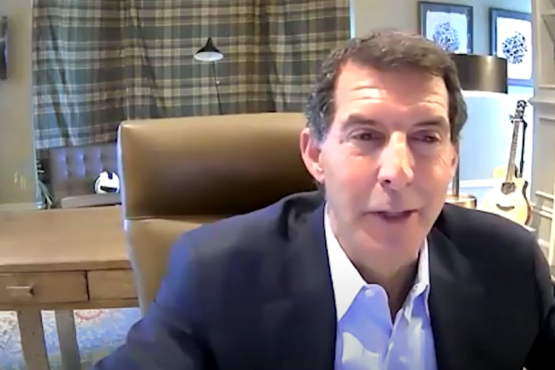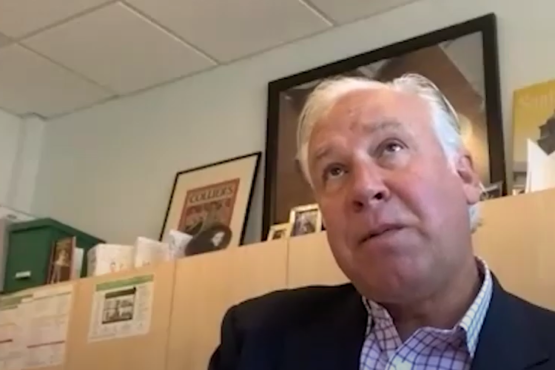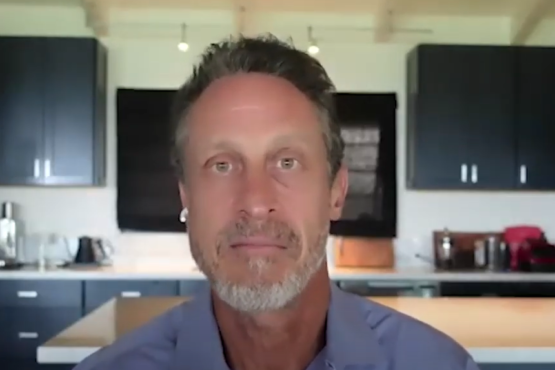Emily Evans is the Managing Director of health policy for Hedgeye Potomac Research, serving as a translator and tour guide for investors seeking to read the tea leaves coming out of Washington, D.C. She previously spent 20 years financing healthcare facilities in the tax exempt sector for J.C. Bradford and Avondale Partners. In our discussion, we delve into the healthcare pricing policies coming out of the current administration in Washington. And now please join me and our guests for A Second Opinion. Emily Evans, thank you for being with us today.
Bill Frist: Welcome to A Second Opinion podcast where we are rethinking American health. I’m your host, Senator Bill Frist. To make sense of all the dynamic perspectives in healthcare, you need a trusted source engaging at the intersection of policy, medicine, and innovation. You need a second opinion, a podcast where it all comes together. In today’s episode, we have Emily Evans of Hedgeye Potomac Research joining us. But before we get started, I want to thank our sponsors. A Second Opinion is powered by MEDHOST, a trusted EHR for healthcare facilities. We’re also brought to you by Jarrard Phillips Cate and Hancock, the preeminent trusted strategic communications firm devoted to healthcare providers. Now let’s turn to the episode. Emily Evans is the Managing Director of health policy for Hedgeye Potomac Research, serving as a translator and tour guide for investors seeking to read the tea leaves coming out of Washington, D.C. She previously spent 20 years financing healthcare facilities in the tax exempt sector for J.C. Bradford and Avondale Partners. In our discussion, we delve into the healthcare pricing policies coming out of the current administration in Washington. And now please join me and our guests for A Second Opinion. Emily Evans, thank you for being with us today.
Emily Evans: Thanks for having me.
Bill Frist: Yes, and really appreciate it. The healthcare world needs people just like you. Make your voice loud and push it along to give some order and discipline to all of this chaos that’s out there. Well tell us a little bit, the Hedgeye Potomac Research Group, a little bit of the history there and then let’s jump right in with a topic. I think the topic that is top of mind to a lot of people, is pricing. But let’s come back to that. What about Hedgeye Potomac?
Emily Evans: Hedgeye Potomac research is an independent research group that serves the investor community. So our clients are hedge funds, mutual funds, venture capital funds, that sort of thing. My job is to be the policy analyst. So I am a translator and a tour guide, if you will-
Bill Frist: I love it.
Emily Evans: … for investors. Trying to help them understand how to understand what is going on in Washington with respect to their investments in healthcare and how to avoid mistakes and problems, and so forth.
Bill Frist: Investors would be individuals or private equity or venture capital groups, or [crosstalk 00:02:40]?
Emily Evans: It’s predominantly hedge funds but also mutual funds, brand names you’ve heard of. Also private equity funds. Also brand names you’ve heard of and a little bit of venture sprinkled in there as well. Yeah, it’s-
Bill Frist: Yeah, the translator.
Emily Evans: I call myself a translator and a tour guide.
Bill Frist: Exactly, exactly. We’ve had the last two or three or even four years in the country looking at access issues or it’s been done at the policy level. We just as well could have been looking at the cost issues and clearly they’re interrelated. But through Obamacare, most people in affordable care, most people would say it was mainly access-
Emily Evans: Oh, yeah. Absolutely.
Bill Frist: … and it ended up being some good things and some not so good things, but trying to move the ball down the field. The spending issues, the cost issues, the whole value equation of the denominator being some sort of pricing or cost and the numerator being some kind of outcome or quality. It starts moving you in a direction if you’re going to talk about what people are worried about around the dinner table is, “I can’t afford it. My deductibles are too high.” So there has been this whole initiative that, well if the value equation is that, we got to know what the denominator is. We got to know what prices are as a surrogate. And so now, we have some new legislation in new law with pricing and they’ve recently been posting prices. Now step back and take that as the introduction.
Emily Evans: Okay. So under the Obama administration, and to be very fair, I would say this was the policy of Bush tow for sure, Clinton administration and maybe even Bush one to a lesser degree. It’s a focus on supply side issues, access issues, value based purchasing, those kinds of things with very little regard to the price of stuff. And the public didn’t really care because I had pretty good insurance for the most part, especially when the economy was doing well. The deductibles were manageable. The copays were manageable. Everything was fine. So, even though price is a little out of control before Obamacare, really didn’t hit home. Well then with the passage of the Affordable Care Act, Congress poured $1 trillion on that fire and it was like gasoline. So suddenly-
Bill Frist: Yep, took off.
Emily Evans: … you have a lot more coverage, a lot more access, a lot more people bidding up the market, if you will. If you look at the utilization throughout the Affordable Care Act, you can very clearly see what was going on. And then at the same time that the Affordable Care Act burdened the health insurance system with things that Congress wanted it to do. Even the IOM, Institute of Medicine, wasn’t so sure were good ideas.
Bill Frist: Yep, absolutely.
Emily Evans: They put out this really big report after the passage, but Congress still did it and they a burdened the system with so many more costs that exacerbates. So where you end up is higher deductibles, narrower networks, less coverage and benefit systems that work like Medicare Part for a great example.
Bill Frist: Right.
Emily Evans: Don’t really work anymore.
Bill Frist: Yeah, yeah. Yeah.
Emily Evans: You have Medicare Part D is a great benefit, but you now have people who are having to make decisions about Medicare covered prescriptions, the financial decisions that they didn’t have to make in 2010. So that’s where we are today. The Trump administration is taken a very different view from prior administrations, which is you don’t know if it’s going to work but we didn’t know if anything else is going to work either. It’s the prices. We got to focus on the prices.
Bill Frist: It’s the prices, too. It was ride hard. One of my mentors who died unfortunately two years ago-
Emily Evans: Oh, so [inaudible 00:06:37].
Bill Frist: But his seminal paper comes back to the prices.
Emily Evans: It is the price and the price is why healthcare is 20% and if we would really put a pencil to it and really added everything in, I imagine it’s more than 20% of the GDP. That’s why it’s eating the economy. And I told the health fellows class, the nation that implemented the Marshall Plan and built the Hoover Dam is now fixated on its UTIs and kidney section. It’s like-
Bill Frist: Tell me just on the prices issue, because that is where I think most of the national conversation is going to be on spending. And I’ll start with what you said, 18%, 70 more a percent of the GDP. That doesn’t mean much to your average person who cares about food on the table and prescription drugs and enough money to pay a deductible. So I think it’s going to come down quickly. But to start that, when you say prices versus spending versus cost, just comment on the three of those so our listener will understand, that they aren’t exactly the same but they’re related.
Emily Evans: Right. So the way I look at this is the price and healthcare has differential pricing, just like airlines, right?
Bill Frist: Right.
Emily Evans: You buy a ticket the day before, you pay one price than if you I bought it three weeks before, which is acceptable to a certain degree. But unlike the healthcare industry, those prices are pretty irrational. For example, somebody who walks into the hospital and is uninsured and has money in the bank, pays a very different price than somebody who is insured who may be in the same financial circumstances because the cash price versus the negotiated price with the insurance. So there’s a lot of irrational. So that’s the way I think of prices. The cost, which because healthcare’s never really had to worry about prices, it’s never really worried about cost either. So the costs are hard to identify and this is why I think when we talk about what percent healthcare is in the American economy. We don’t really have an accurate number because we’re not taking it-
Bill Frist: No, and what is cost? Is it opportunity cost. Is it I had wait in a waiting room all day and I missed work. What is that cost?
Emily Evans: Yeah, exactly. But if you’re just going to look at it in the balance of accounts kind of way, you’re looking at the labor and the IT and all of those things that almost… Medicare’s tried to do this with a cost reporting system, but almost nobody knows what those are. Most hospital executives I think will tell you that it’s the case, except for the publicly traded ones who have to answer to their investors. Different-
Bill Frist: And then, the third category on the spending. Again when we see spending do we mean and when the government reports spending, is it all of the money actually spent deductibles out of pocket, Medicare, Medicaid, private health insurance, is it everything?
Emily Evans: The best number we have is the national health expenditure number that comes out of the office of the actuary at HHS. That is missing a lot of critical things like drugs that hospitals dispense, for example, are not in there, which is several. That’s $20 or $30 billion I think. That’s one thing that’s not in there. It doesn’t include IT costs, for example, accountants, architect. Doesn’t include any of those things that are dependent on the health industry. So we don’t really, know what it costs and which is a little frightening when you think about it. But the price transparency efforts that the Trump administration has undertaken is designed to get you one step closer to, “Okay. What does it cost?”
Bill Frist: Yeah, at least your starting point… And now, a quick word from our sponsors that make this podcast possible. For 35 years, MEDHOST has been partnering with community hospitals and specialty healthcare facilities to focus on what matters most. Effectively taking care of their patients. Trusted by over a thousand healthcare facilities, MEDHOST offers a full suite of healthcare IT and business solutions, including an EHR and emergency department information system. Healthcare providers need a partner who can help them meet patient needs with the agility. Backed by world-class support, MEDHOST solutions are an ideal match for facilities wanting to enhance patient care. To learn more, go to medhost.com.
Bill Frist: The Second Opinion podcast is sponsored by Jarrard Phillips Cate and Hancock, the premier strategic communications firm or healthcare providers and producer of the Art of Change. Healthcare is in a moment for big choices, big risks and big chains. How do you take advantage of that? Now, Jarrard is demystifying the Art of Change through interviews with transformational leaders, historical examples and fresh insights. Art of Change will give you the context in tactical approaches to empower your organization and healthcare for the future. Go to jarrardinc.com/secondopinion to learn more and subscribe. That’s jarrardinc.com/secondopinion. And now, back to the episode. So tell the listener and me, what did the Trump administration do on pricing and posting a price?
Emily Evans: So the first thing that they did, they required ,as of January 1, hospitals have to post their prices. Now they say, “Look, we know prices. Is a price in healthcare is a highly debated number but you want to put your chargemaster up there? Put it up there. If you want to put something else up there, put it up there.” So hospitals have responded by posting these in machine-readable form on the internet. So if you’ve got a good coding department, you can go and scrape those out and aggregate them and create a time series and you could actually look at prices. Now this was-
Bill Frist: Are they posting them in the hospital on the wall or signs at all or is it all-
Emily Evans: It’s all on the internet. It’s all… If you go to usually under the financial part of the website for a hospital, you’ll-
Bill Frist: And they have to do it. So it’s there where it’s supposed to be.
Emily Evans: And it’s machine-readable. It’s not a brochure that they hand you at the hospital, which is what they’ve been doing since the Affordable Care-
Bill Frist: Machine readable, does that mean it’s easy to read or it’s hard to read? I know a machine can… What does that mean?
Emily Evans: It means that a machine can read it.
Bill Frist: Yeah, is that good or bad?
Emily Evans: That is good because the data can be aggregated from all-
Bill Frist: And analyzed, yeah.
Emily Evans: … 3,500 hospitals. All right. So their numbers aren’t actually what any one individual would pay. So people have criticized that. They’ve said, “Oh, well that’s not a good policy because that’s not what anybody really pays.” But if you’re the low cost provider in your community and you’re posting your low prices up there, how long do you think it is before you don’t start pointing out that you’re the economic alternative in your hometown?

Bill Frist: Yeah. So the comparisons, at least on what’s out there in the computer, pulled out can be made.
Emily Evans: So what’s the high cost provider going to say? “Oh, well that’s not really our price.”
Bill Frist: Yeah.
Emily Evans: That’s not a great response for in a marketing kind of environment. So this is just a first step. They recognize that, but I think that the market and marketing will play a role in moving those prices to something that is actually real. Okay. And that was a big step. This is deepen, protecting chargemasters and for years and years and years and now ,they are out there-
Bill Frist: How did they get it done? Did they just say-
Emily Evans: They put in it in a rule.
Bill Frist: “January 1st, it’s going to happen?”
Emily Evans: They put it in a rule, and they just said… And not only that, they said, this is HHS we’re talking about here. But what they said is, “We are also considering making price transparency a condition of participating in Medicare.”
Bill Frist: Yeah, huge.
Emily Evans: So that, which the American Hospital Association is not thrilled with to say the least. But they may take that next step of making transparency and disclosure of prices part of participating in the Medicare program, which would in effect cover every hospital in America. So that’s a big step.
Bill Frist: Could you have any idea or in the dialogues, I know you’ve, you’ve talked to all of these principles, what that next step would be in terms of the pricing end of it?
Emily Evans: It’s not clear what the next step would be. I think what they were waiting to see, is see how the industry reacts. I think they have a couple of ideas, and I think the very first is to standardize that information. So if you pull up this information, you’ll see some hospitals include their CPT codes and the common code that everybody writes down when they do a procedure. They have include those, they include the list price and then, they have additional information. Others are not giving as much information.
Bill Frist: Is there a downside or is there a negative side by just listing? It’s a good first step. You’re optimistic in the impact from in a more consumer based world. Is there any downside to it?
Emily Evans: I don’t think there is. Now, I think that the hospitals will say, “Well, it doesn’t reflect quality.” Now this is back to where we started here. It doesn’t reflect the different quality you might get, but I’m not sure that’s going to hold water because when I talked to the fellows, I pointed out there’s three hospitals within roughly two miles of each other in Midtown Nashville and they all are publishing very different prices for a knee replacement. Pretty sure a lot of them all went to medical school together.
Bill Frist: That’s right.
Emily Evans: And I’m pretty sure that they’re all really good doctors. So not sure I buy that argument. Not sure the public’s going to buy that argument, but I think that’s the response. But once you get to where you know what things cost or you know what the price is, then you can start asking your self the next question, which is, “What do I get for my money?”
Bill Frist: Yeah, that’s right. It’s a natural question. You’re going to as that.
Emily Evans: I don’t think there’s any question certainly for some types of cancer and some rare diseases. Vanderbilt University just is phenomenal. You wouldn’t send your loved one anywhere else. But maybe for a knee replacement? Maybe it is price competitive. We’re going to have to see.
Bill Frist: You have a lot of confidence in the consumer recognizing… Not everybody has to be a smart consumer, just a few people in the room and that can drive the whole system. It always interests me with the deductibles going from $200 five years ago to $5,000, $7,000 today. At least you initially say, “Okay, people are going to at least start shopping more when they see this three times three fold price differential.
Emily Evans: Right.
Bill Frist: Is that occurring? Does raising deductibles, force people… Not force people, encourage people to become smarter shoppers to the point that prices will or are coming down?
Emily Evans: That’s a long range goa and a long range effect I think, because the thing that drives you to consume healthcare is almost always your doctor. What your doctor recommends, what your doctor suggests. Now I think over the last five years, we’ve seen doctors become more sensitive to price.
Bill Frist: As patients asks, they become-
Emily Evans: As the dynamic has changed, and I’ve watched this with my doctor as he says, “Well, we can do this but maybe we should try this first.” I have great health insurance. So they are thinking about those things and then I think that is how that will work. Where I’m not going to wrack up… I’m already thinking about price and costs to you as a patient because I don’t want you to be in financial distress as a result of this illness. So let’s solve this problem together. But that I think is the dynamic that will play out.
Bill Frist: This whole pricing issue and consumer based world that we’re moving to, as more data and better data, which is what we’re talking about comes forward. Leads me to be more optimistic than I was say four or five years ago. You see so much. We’ve talked about one issue and I look forward to talking to you many times in the future about all the thousands of other issues that are out there. But on this particular issue of pricing and consumerism having an impact on this system, are you optimistic or neutral or pessimistic in the direction we’re moving?
Emily Evans: I’m actually pretty optimistic because the system has to deflate. We will be facing a period of time where the healthcare as the healthcare will flatten out as a part of the American economy, and the American economy will continue to grow. So it takes a smaller and smaller chair. I think that’s where we will end up. I’m pretty optimistic that that’s going to happen because as Dr. Van Horn has pointed out, its economic gravity that’s pulling this thing down. Unfortunately, a lot of Americans are getting caught in this vice grip of high deductibles and high costs, but that’s not a sustainable situation. It’s not a sustainable answer. As telemedicine develops, we’re not going to call it telemedicine in three or five years. We’re going to call it medicine. So remember, we called it telebanking for a brief while. We’re not going to call it… As those low cost solutions come in to play and become viable and scale, I think it’s going to really make a big difference.
Bill Frist: Yeah, no, I agree. I tend to be very optimistic or optimistic for the same for the same reasons.
Emily Evans: And at the same time, I think that we can see innovation take place. We can see there’s a reason that people come from all over the world to be treated in the United States for diseases. It’s because this is one of the greatest places for research and innovation across the book. I think that’ll continue to happen. I think that’ll in a healthy way.
Bill Frist: Yep, exactly. Well, Emily Evans, Hedgeye Potomac Research Group. Thank you so much for being with us-
Emily Evans: Oh, I enjoyed it.
Bill Frist: … and look forward to many, many conversations in the future. Thank you.
Emily Evans: Oh, thank you very much.
Bill Frist: This episode of A Second Opinion was produced by Todd Schlosser, the Motor’s creative group team and Snapshot Interactive. You can subscribe to A Second Opinion on Apple Podcasts or wherever you are listening right now. And be sure to rate and review A Second Opinion, so we can continue to bring you great content. You can get more information about the show, it’s guest and sponsors @asecondopinionpodcast.com. That’s asecondopinionpodcast.com. Thank you again to our sponsors, MEDHOST and Jarrard Phillips Cate and Hancock. Be sure to join us for our next episode with bestselling author, Sam Quinones, the fascinating crime reporter who vividly describe how he became one of the leading experts on the drivers of the nation’s opioid epidemic. A Second Opinion broadcast from Nashville, Tennessee, the nation Silicon Valley of health services where we engage at the intersection of policy, medicine, and innovation.
